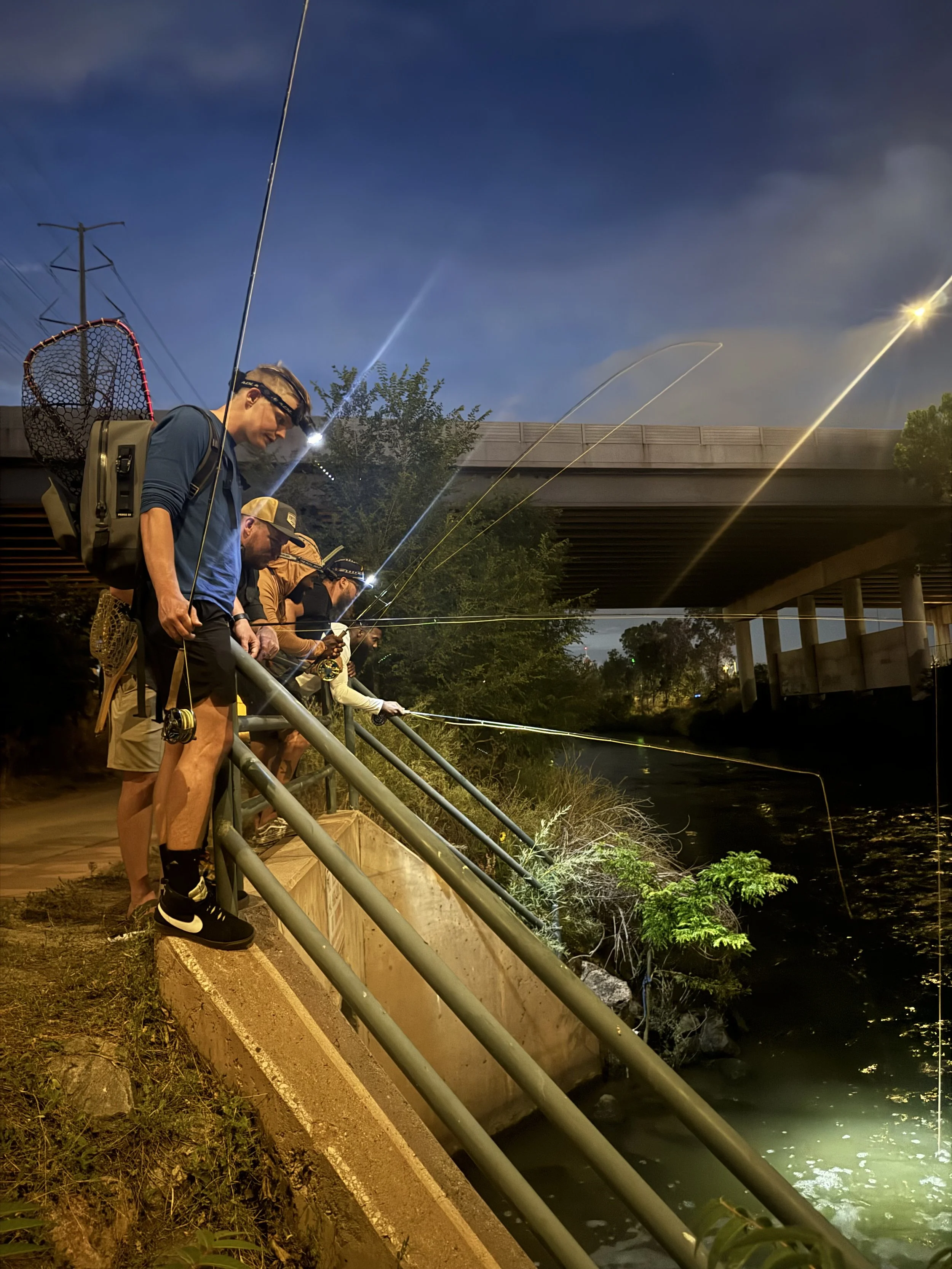| Site | Location | Update |
| Lower Creek
(Updated 12/18/17) |
Boulder, CO, near Jamestown, CO | We are receiving our final report from the Lefthand Watershed Oversight Group (LWOG) detailing restoration success at a former informal gun range that TU, the Arapaho Roosevelt National Forest and RMC Consultants cleaned up in 2015. LWOG has been partnering with us this summer to monitor the site and has reported some extremely positive findings. LWOG’s monitoring data are showing at least a four-fold decrease in total lead concentration in surface waters as compared to pre-construction levels, and an even more impressive 14-fold decline of lead concentrations in streambed-sediments as compared to pre-construction levels. These results demonstrate the success of our project and our partnerships in this watershed, and promise continued environmental health for the area. |
| Fourmile Creek | Boulder CO, near Gold Hill, CO | Trout Unlimited and the Fourmile Watershed Coalition have successfully partnered to complete active water quality sampling and flow monitoring along multiple sites located in the Fourmile Watershed. These samples have been sent to Fort Collins for analyzing and we are awaiting the results. We are hopefully awaiting a grant to continue our proactive research with more high flow and low flow sampling at additional sites. |
| Doctor Mine | Empire, CO | We plan to monitor water quality at this site to monitor the overall effectiveness of work completed in 2014. |
| Lion Creek
(Updated 12/18/17) |
Empire, CO | We just wrapped up a really interesting project with USGS and the Arapahoe Roosevelt NF in the Lion Creek watershed. This project utilized a sodium bromide tracer injection at the upstream Minnesota Mine shaft to understand pathways of connectivity between contaminated groundwater and surface water within the watershed. Understanding these pathways will help us focus future restoration efforts in the watershed in the most effective way possible. We look forward to applying the lessons learned from our data in the coming seasons to continue to improve downstream water quality for Clear Creek and its valuable ecological resources. |
| Leavenworth Creek
(Updated 12/18/17) |
Georgetown, CO | TU, Arapaho Roosevelt National Forest, and H2 Enterprises completed tailings removal and amendments on approximately three acres of tailings in the Leavenworth Creek watershed in October. All of the improved areas were seeded with native alpine species and mulched to encourage healthy revegetation at the site. In addition to tailings removal and amending, project partners also created multiple sustainable drainage ditches to control drainage on the site, and planted approximately 300 willow stakes in those ditches. Preliminary soil testing revealed decreased soil acidity and decreased concentrations of metals in soils across the site but final testing and revegetation evaluation will be done next spring/summer once the site is accessible. In addition to the tailings work in the Leavenworth watershed, TU and our partners also completed revegetation at the Santiago Mine and Mill building. We expect that our efforts will contribute to a healthier watershed within Leavenworth Creek and increased downstream water quality for the Town of Georgetown and Clear Creek. |
| Illinois Gulch | Breckenridge, CO | Our project proposal for construction on Illinois Gulch has been approved and we are looking forward to working with the EPA, property owners, and Summit County to have the best reclamation project possible. Work should begin in Late August/ Early September. |
| Chalk Creek | Buena Vista, CO | A site visit at the end of this month (July) will help us to determine the best ways to improve site drainage and overall maintenance. This project also offers us the unique opportunity to build a relationship with the Pike San Isabel Forest Service. |
| Minnie Lynch Mine
(Updated 12/18/17) |
Villa Grove, CO | TU, Rio Grande National Forest and Iron Maiden, Inc had an extremely successful construction season at the Minnie Lynch Mine site. This year, project partners removed tailings material from the site, established drainage controls to reduce contaminated sediment erosion into Minnie Lynch Gulch, developed a sedimentation basin on site and revegetated the site with native species. This year’s work compliments two previous phases of work completed at the site by TU and our partners and contributes to an even higher level of environmental improvement in the Kerber Creek watershed. |
| Stinkingwater Mining District | Cody, WY | We have completed our sampling plan for this area will be working with the USFS from July 31 – August 4 to complete water quality sampling in the district. |
Chapter Youth Education Feedback
Chapter Leaders, As many of you may already know, CTU is undergoing a review of its statewide youth education program. The goal of this process is to create a strategic plan that will help CTU better support local chapter initiatives, increase revenue for youth programming, and develop more targeted state-level projects. We are reaching out to you to get your initial feedback. Before we dive into the planning process, we want to see where CTU and its chapters currently stand – that means identifying current programs, goals, and participants.
In order to help us develop a program that will best support your youth education efforts on the ground please provide the following information:
- What youth education programs you currently have in place;
- What programs you are working on or would like to see in the future;
- The number of participants (youth ages 5-25) that you reach through your current programming;
- The number of partners (teachers, community orgs., etc.) that you work with to implement these programs
- How CTU can best support your youth education efforts
Please feel free to distribute this email to your members who are involved with these efforts. We are hoping to have responses by Friday, June 2 in order to begin moving forward with the next phase of the plan. We understand that collecting this data will demand some work on your end and we greatly appreciate your effort here. By getting your input on the front end of this planning process, we hope to craft a stronger youth program that will provide your chapter with the additional support it needs to continue the great work that you do.
Please reply to Dan Omasta or Jeff Florence
Please let us know if you have any thoughts or questions.
Best,
Dan and Jeff
The rivers need people like you
Long ago, a wise and influential man told me, in a low and gravelly voice that matched the importance of his words, "The rivers need people like you." Last month, I was reminded of these compelling words when I was honored to receive the Silver Trout Award. The award, given by the Silver Trout Foundation, recognizes individual volunteers whose body of work in support of Colorado's rivers has left a significant and lasting impression.
If you were at Colorado TU's Rendezvous 2017, you heard me nervously stumble through an acceptance speech. I had one memorized in advance, but altered it on the spot because of the way I was introduced. I've since been encouraged to share that speech for others and I welcome the opportunity to deliver it without stumbling!
Thank you. I've always been honored to work with such a passionate and committed group of people. Now I'm humbled to be in the company of other award winners.
Ken [Neubecker] mentioned that he met me at a volunteer day where I was flipping burgers, and it reminded me of a story that I'd like to share.
That volunteer day, at Buffalo Peaks Ranch in 2008, was my very first volunteer experience with Colorado TU. Sinjin [Eberle] had enlisted my help to cook lunch. Honestly, I wasn't a TU member or even a river conservationist at the time. I was simply helping a friend out.
The last person I flipped a burger for happened to be the late Charlie Meyers of the Denver Post. I shut down the grill and joined him for lunch. I tried to thank him for the media coverage of the event, but he cut me off and thanked me for helping to restore the river.
We talked about a lot of things and I don't recall the details anymore, but I do remember how it ended. He grabbed my arm to make sure he had my attention, looked me in the eye and said, "You know, the rivers need people like you."
He didn't sound like Morgan Freeman, but I felt like Morgan Freeman had just given me my marching orders. Later that day, I told Sinjin I wanted to get more involved in Colorado TU and the rest is history.
So I was a volunteer, but I didn't really become an engaged volunteer until Charlie gave me the push I needed. We all know someone like this, someone who just needs a push to get involved. I want to encourage all of you to push that person - you might be creating a future Silver Trout Award winner. Thank you.
I added the bit about Morgan Freeman. Sure wish I'd thought to say it at the podium!
For those who don't know, Ken Neubecker is the current President of the Silver Trout Foundation and a past president of Colorado TU. Sinjin Eberle, who was a good friend even before the Buffalo Peaks Ranch projects, is the Director of Communications for American Rivers and a past President of Colorado TU. Both are Silver Trout Award winners.
Charlie Meyers, an outdoors writer for the Denver Post, covered his beats for 40 years. He died in January of 2010 from complications due to lung cancer.
Yampa-White Project Coordinator
ABOUT TROUT UNLIMITED
Trout Unlimited (TU) is a national conservation organization with a mission to conserve, protect and restore North America's cold-water fisheries and their watersheds. From the beginning, TU has been guided by a principle grounded in science: if we "take care of the fish, then the fishing will take care of itself." With more than 155,000 volunteers organized into ~400 chapters nationwide, this dedicated grassroots army is matched by a respected staff of organizers, lawyers, policy experts and scientists, who work out of more than 30 offices across the country.
POSITION SUMMARY
TU's Western Water and Habitat Program seeks a Project Coordinator to plan and implement on-the-ground projects that conserve and improve trout habitat in the Yampa River and White River basins in northwest Colorado. The Coordinator will be a TU employee, and for at least two years, work in a cost-share, partnership position with Natural Resources Conservation Service (NRCS). The Coordinator's work plan will be jointly developed by TU and NRCS, and the Coordinator will assist both TU and NRCS staff. Projects will include efforts to improve irrigation infrastructure and stream flow, remove fish passage obstacles, and restore instream and riparian habitat. The Coordinator will be located in Steamboat Springs, CO. Continuation of the position beyond two years depends on the availability of funding.
DUTIES AND RESPONSIBILITIES
The Coordinator will work closely with water users, private land owners, agency staff, and personnel from other non-profit organizations. Primary responsibilities will be to:
- Develop relationships with the agricultural community and agency staff.
- Assist private landowners with enrollment in Farm Bill assistance programs.
- Plan and oversee projects.
- Raise funds, as necessary, to implement projects.
- Manage grant application and reporting requirements.
- Identify opportunities and make recommendations for acquisition or appropriation of instream flow water rights.
- Monitor project effectiveness.
Other responsibilities may include:
- Working with agency staff and water providers to advocate for fish-friendly water management.
- Sitting on technical advisory committees.
- Completing other appropriate tasks as needed.
QUALIFICATIONS
- An advanced degree in biology, ecology, hydrology, engineering, or another related field.
- Work experience and skills in aquatic ecology/biology.
- Strong interpersonal and communication skills.
- Knowledge of irrigation systems and experience working with irrigators.
- The ability to secure grants and manage project budgets.
- Practical problem-solving skills and a proven track record of attaining goals.
- Ability to work with experts on, hydrologic modeling, water rights engineering, GIS mapping, instream flow quantification methodologies, biological sampling, and data analyses.
- Willingness to travel locally.
- Passion for the outdoors and TU's mission is essential. Fly fishing is a plus.
HOW TO APPLY
Please submit a cover letter, CV, writing sample, and list of three professional references to Brian Hodge at bhodge@tu.org. Include the words "Yampa-White Coordinator" in the subject line. No phone calls, please. Applications will be accepted until May 31 or until the position is filled.
This is not an all-inclusive list of duties and responsibilities.
Please fill out this voluntary form and submit it as an attachment to this email address.
TU is an Equal Employment Opportunity & Affirmative Action Employer pursuant to Section 503 of the Rehabilitation Act & Vietnam Era Veterans Readjustment Assistant Act.
TU hires staff without regard to race, color, religion, national origin, age, gender, sexual orientation, marital status or disability.
2016 Annual Report
The 2016 Colorado TU Annual Report is now available! This year we broke it down basin-by-basin to show that no matter where you fish, Colorado TU is on-the-ground working to make the watershed healthier, protect the lands and streams, and ensure that the fish habitat is sustainable for future generations.
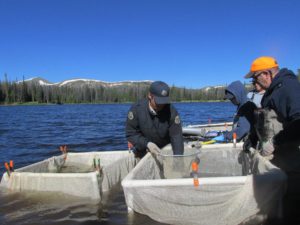 In the South Platte basin, Colorado TU and chapters worked to engage young, inner city, girls through the great outdoors by introducing them to fly fishing and conservation; CTU worked with Colorado Parks and Wildlife to reintroduce the Colorado state fish, Greenback Cutthroat Trout, to it's native watershed along the Front Range; Trout Unlimited tackled abandoned mine issues, and various chapters worked to repair their homewater streams from the devastating floods of 2013.
In the South Platte basin, Colorado TU and chapters worked to engage young, inner city, girls through the great outdoors by introducing them to fly fishing and conservation; CTU worked with Colorado Parks and Wildlife to reintroduce the Colorado state fish, Greenback Cutthroat Trout, to it's native watershed along the Front Range; Trout Unlimited tackled abandoned mine issues, and various chapters worked to repair their homewater streams from the devastating floods of 2013.
The Arkansas River basin is home to Bear Creek where the last wild population of Greenback Cutthroat trout were found. The Annual Report discusses how CTU and the local chapter worked to connect this rare fish with the community. The Arkansas River basin also included the Colorado TU Youth Camp where 15 students ages 14-18 were introduced to the basics of conservation and fly fishing.
The San Juan, Animas, and Dolores basins included work on restoring the trout habitat and cutthroat trout populations into Hermosa Creek, rerouting the San Miguel river through the Telluride Valley Floor, and protecting the southwest rivers and streams from hardrock mining issues.
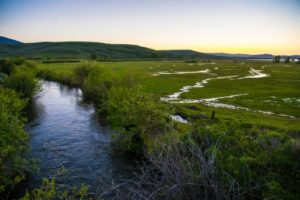 In the Colorado River basin, TU helped secure protections for the Roan Plateau and Thompson Divide from harmful oil and gas development, worked with local ranchers and farmers to improve the health of the Upper Colorado while enhancing agriculture water usage. TU also helped lead the Learning by Doing initiative that, among other things, secured $8 million in funds to protect and restore the Upper Colorado River.
In the Colorado River basin, TU helped secure protections for the Roan Plateau and Thompson Divide from harmful oil and gas development, worked with local ranchers and farmers to improve the health of the Upper Colorado while enhancing agriculture water usage. TU also helped lead the Learning by Doing initiative that, among other things, secured $8 million in funds to protect and restore the Upper Colorado River.
Along the Yampa, Trout Unlimited's Brian Hodge was rewarded the U.S. Forest Service’s Rise to the Future Award for his work restoring miles of streams and trout habitat in the Routt National Forest. The local chapter also worked to engage youth in the basin by connecting them to their local watershed and introducing them to the issues present.
The Gunnison River basin included engaging youth through the Adopt-a-Trout program in Tomichi Creek where students, in collaboration with local agencies, tagged wild trout to study the movements of fish in the creek. TU also worked with local farmers and ranchers to improve agriculture processes and trout habitat in the Gunnison valley.
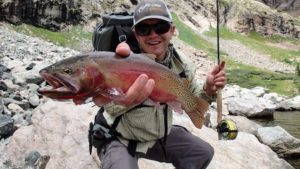 In the Rio Grande basin, Trout Unlimited worked to protect the Great Sand Dunes Cutthroat from potential changes in the environment. The Rocky Mountain Flyathlon came to Saguache for the annual race and fishing events that help raise money for Colorado TU's work in protecting native trout and their habitats. The local chapter and Trout Unlimited also worked to repair sections of the Conejos and ensure that winter flows were hospitable for trout.
In the Rio Grande basin, Trout Unlimited worked to protect the Great Sand Dunes Cutthroat from potential changes in the environment. The Rocky Mountain Flyathlon came to Saguache for the annual race and fishing events that help raise money for Colorado TU's work in protecting native trout and their habitats. The local chapter and Trout Unlimited also worked to repair sections of the Conejos and ensure that winter flows were hospitable for trout.
The work we accomplished last year could not have been done without the generous support of our donors and partners listed on page 23 of the Annual Report. All donations to Colorado TU are leveraged through corporate partnerships, volunteer sweat equity, and matching grants to make your dollars go even further!
There are many more stories in each basin and projects from around the state that you can read in the 2016 Annual Report. You can view the report here or make sure you check it out in the Spring edition of High Country Angler!
Senate Committee Kills CPW Financial Sustainability Bill
Last Friday, the Senate Finance Committee, on a 3-2 vote, killed House Bill 17-1321, the Colorado Parks and Wildlife financial sustainability bill. CTU supported the bill, considering the modest ($12.50 maximum) increase in an annual fishing license fee, along with reinstating a discounted senior fishing license, to be reasonable asks from an agency that has not seen a fee increase in 12 years - even as its revenue buying power was eroded by inflation over those years. Among the priorities that would have been funded through the bipartisan bill were needed maintenance on CPW reservoirs (some of which otherwise may face draw-down orders for dam safety reasons), restored funding for the "Fishing is Fun" grant program to help develop fishing opportunities in communities statewide, expanded investment in public hunting and fishing access, and sustainable funding for aquatic nuisance species inspections of boats coming onto key Colorado lakes and reservoirs.
In recent years CPW has already cut $40 million and defunded 50 staff positions. With the failure of HB17-1321, the agency will have to wait at least until the 2018 legislative session for possible financial relief.
Celebrate Colorado's First Ever Public Lands Day
Residents will have the opportunity to celebrate Colorado’s inaugural Public Lands Day on May 20. Made official in 2016, Colorado Public Lands Day will be held on the third Saturday of May each year to recognize the contribution of public lands to our state’s economy and its residents’ quality of life. Colorado has 24 million of acres of public lands, nearly one third of the state’s landscape, that allow hunters and anglers to have access to some of the best fish and game habitat in the world. These federal public lands are responsible for boosting Colorado’s economy by $722 million every year and provide 45,000 jobs to the state. Colorado Public Lands Day is an opportunity to publicize how important these lands are to our State and our heritage as sportsmen.
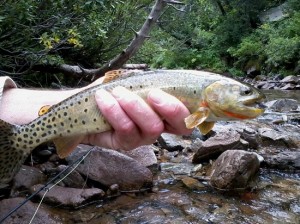 There is a small but dangerous movement brewing in this country that would transfer ownership of federal public lands to the states. TU and many other sportsmen’s organizations have been working to defend public lands from this catastrophic concept. On May 20, Coloradans now have a chance to make our voices heard and show the country how much we care about our public lands in the Centennial State. It's our chance to show legislators and the rest of the country that the majority of sportsmen and residents of Colorado strongly believe public lands need to remain public.
There is a small but dangerous movement brewing in this country that would transfer ownership of federal public lands to the states. TU and many other sportsmen’s organizations have been working to defend public lands from this catastrophic concept. On May 20, Coloradans now have a chance to make our voices heard and show the country how much we care about our public lands in the Centennial State. It's our chance to show legislators and the rest of the country that the majority of sportsmen and residents of Colorado strongly believe public lands need to remain public.
As part of your Colorado Public Lands Day celebration, we ask that you join us in tweeting or emailing a photo of a fish caught on public lands to Sen. Gardner and Sen. Bennet with the hash tag #CoPublicLandsDay and a message reminding them how important federal public lands are to Colorado’s residents. Also, send the photo to Colorado TU's Facebook and Twitter so we can keep track of the impact you have as a member of TU. CTU will be sending out an Action Alert with more instructions to come. We all enjoy the opportunity to boast over a photo of a fish we have caught, now we can enjoy our accomplishment and help protect the places we love while we are doing it.
For more information on other Colorado Public lands Day event please visit: www.copubliclandsday.com.
Secrets of Fly Fishing the Lowly Carp
Webmaster's Note: The following is a guest post from Rich Stuber, the founder of Big Sky Inflatables, home of Water Master Rafts. Water Master has been used by anglers and hunters all over the world for over fifteen years, including Dave Whitlock, one of fly fishing’s greatest innovators.
It was a warm, really pleasant day on the Dream Stream (the South Platte River) near Lake George, Colorado. Trout were hitting well on San Juan worms and nymphs, and even though the water was a bit murky, we had been catching some nice browns and rainbows. A single prince nymph under an indicator had been working well, and as the setup rounded a bend into dead water, the indicator took a dive. Raising the rod to set the hook met solid resistance so much so that it seemed as if it was hung on submerged structure. Just as quickly, the line started screaming off my reel, downstream, and the fight was on. A chase along the river bank ensued, as the 6X tippet on my line wouldn’t hold for long. After a strong fight, the fish rolled the surface and revealed the bright gold scales of a five pound common carp. This was no disappointment, as any fiver on a fly rod is a treat. The "freshwater redfish" as many call carp, is the newest and maybe the most challenging target for many anglers today.

There are five species of carp that we see in the U.S.
- Grass Carp, up to 60” long, 99lbs., feed on aquatic plants
- Big Head Carp, up to 60” long, up to 110lbs., feed on zooplankton
- Black Carp, up to 48” long, up to 78lbs., feed on snails, mussels, invertebrates
- Silver Carp, up to 40” long, up to 110lbs., feed on photo plankton
- Common Carp, up to 40” long, up to 100lbs., feed on water plants, crustaceans, crawfish, benthic worms, scuds, san juans, snails, clams
There are some variants such as the Mirror Carp, with larger scales, varied colors and placement; and the Leather Carp, with no scales, except some near the dorsal fin.
 Typical targets in fly fishing are common carp and grass carp. The habitat of carp is varied and they are found in a wide variety of waters all across the United States. Most typically, they’ll be found on flat areas, such as in Lake Michigan, in slow and slack water in creeks, streams and rivers, and in just about any lake you come across.
Typical targets in fly fishing are common carp and grass carp. The habitat of carp is varied and they are found in a wide variety of waters all across the United States. Most typically, they’ll be found on flat areas, such as in Lake Michigan, in slow and slack water in creeks, streams and rivers, and in just about any lake you come across.
Fly anglers typically look for carp along the edges in shallow water, because fishing for carp is mostly a sight-fishing event. It can be very difficult to place a fly in the right place to be taken if you cannot see the fish, and the take itself is hard to detect without seeing it happen. That doesn’t mean that a carp won’t slam a fly, because sometimes they will.
Depending on the food source they have, their eating habits will differ-sucking in clams on the bottom, eating nymphs in the water column as they swim along, chasing bait fish in the shallows, or rising to slurp in a floating mulberry or dead insect on the surface. When feeding, they’ll swim along, looking side-to-side, searching or be head-down, tail up, eating from the bottom (tailing).
Gear for Carpin’
- Carp are strong and large, usually weighing five pounds or more, so a strong rod is necessary. A 6-8 weight rod is recommended, and 9’ works well. Beside the strength of the fish, one needs the ability to fling weighted flies into the wind on occasion.
- Nothing fancy on fly line, just match the line to the rod.
- A good reel, with capacity for backing is important, because even a ten pound carp can take you well into your backing, and make several runs. They habitually bolt when you try to get them to the net, often for a fresh strong run.
- You’ll want strong leader, ten-pound test or better, and in most cases, monofilament is fine. You can use a redfish or bass tapered leader, 3X or stronger, for better turnover, but in most cases the mono is adequate. Whether to use nylon or fluorocarbon is your choice, the carp masters differ in their opinion of which is best.
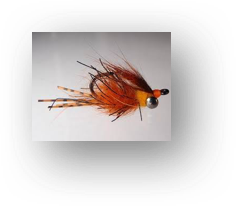 Flies
Flies
Many carp anglers tie specialty flies for catching carp, imitating the food sources, such as the Hybrid Carp Fly or the Backstabber, popular mainstream carp flies. The reality is that much of the time you’ll catch carp doing the same thing you do with trout - match the hatch.
- Aquatic creatures-carp eat nymphs and pupa of mayflies, dragonflies, damsel flies and stoneflies, so flies you use to imitate those work
 Plant material-they like fluffy cottonseeds and love mulberries, so flies that look like those two foods work
Plant material-they like fluffy cottonseeds and love mulberries, so flies that look like those two foods work- Introduced foods - if you fish an environment with human presence, carp will be eating things thrown into the water, and there are flies to imitate foods like bread, dog food, corn, etc.
- Try these: GR Hare’s Ears, dragonfly nymphs, scuds, leeches, san juan worms, crawfish, woolly buggers, Carp Boobies, Bristle Leeches
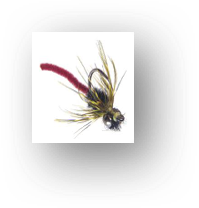 Some popular concepts: weighted flies that sink, hook point up, flies with legs that stir up mud or silt
Some popular concepts: weighted flies that sink, hook point up, flies with legs that stir up mud or silt- Tips: clear water - smaller flies; murky water- larger, darker flies
Methods
- GOOD - indicator rig dead drifting the fly just above the bottom, slowly stripped (no wake on the indicator). This method good for murky water where sight fishing is difficult.
- BETTER - drag and drop, casting a two-fly rig beyond the fish, dragging the setup across the surface until the flies are on either side of the carp’s head, then allowing the flies to drop to the bottom.
- BEST - drop the fly one to two feet directly in front of the feeding carp, and watch for the take, when the carp sucks in the fly.
- Strip set is always best, as it is easy to pull the fly out of the carp’s mouth if you trout set by lifting the rod tip.
Tips
- Rub your fly with mud, they have a keen sense of smell.
- Study the water, don’t just start throwing flies - sight fishing to specific carp is most productive.
- Carp like stable weather patterns.
- Watch for tailing, or puffs of mud.
- If you miss a take, let the fly drop, don’t give up.
- Look for tilted fish. When they are cruising level, they’re not eating.
- Try bright flies, carp are curious and will pick up bright objects.
- It’s ok to let your fly ‘sploosh’ on the water, it gets their attention.
- Be stealthy, carp are nervous fish, easy to spook.
- Cast in front of fish, not over them, they ‘line’ easily.
- If you find carp, but they’re not feeding, look for some that are.
The next time you want some excitement, and want to catch a big fish on a fly rod, consider looking for carp. You will be surprised how many bodies of water they inhabit in your area. You may have to do some searching to find them, but the reward of a 7-10 pound hard-fighting fish on the fly rod is worth every step you take. Go carpin’!
If you would like to learn more about fly fishing for carp be sure to check out these podcasts Cruising for Carp and Tactics for Monster Carp.
Fly Fishing Rendezvous
Where: Jefferson County Fairgrounds – Golden, CO When: May 20-21 8:30-5pm
Cost: $8 in Advance, $10 at the door. Scouts in uniform and kids under 12 are free. Use the code "CTU" when purchasing your ticket for a discount!
Website: www.flyfishingrendezvous.com
If you want to start thinking like a fish and fishing like a pro, the Fly Fishing Rendezvous happening May 20-21 at the Jefferson County Fairgrounds in Golden Colorado is a must visit event! There will be more than 30 hours of classes and clinics from the region’s best instructors, authors and fly tyers, including Phil Iwane and Rick Tackahashi.
You can check out the full vendor and class line-up and purchase your tickets online at: www.flyfishingrendezvous.com.
The Fly Fishing Rendezvous has partnered with Colorado Trout Unlimited and Project Healing Waters to highlight and support the vital work they are doing in conservation and support of our country’s veterans. In addition to raffles and silent auctions held at the event that support both of these groups, 10% of the admission fees go to support Colorado Trout Unlimited, and we encourage every angler to join TU and Project Healing Waters on mission in the conservation of our waters and support of the troops. Tickets are $8 in advance and $10 at the door.

As much as any of us would love to have a stretch of river all to ourselves, an isolated fishing hole where big trout eagerly rise to our dry flies, and the lack of cell phone reception gives us a few hours respite from the demands of life, fly fishing at its core is a social sport. For most of us, it was under the guiding hand of a parent, grandfather, or friend that we tied on our first fly, struggled through the basics of casting, and eventually netted our first trout. There is a unique joy in sharing the water with family and friends, seeing the passion for fly fishing awaken in a new angler, and the excitement of working out a difficult drift with your fishing buddies until one of you finally catch that elusive trophy brown that has evaded you the past several hours.
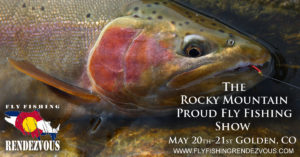 Born from a passion to make the sport of fly fishing accessible to all, and to equip Rocky Mountain anglers with the knowledge and gear needed to experience greater success on the water, the Fly Fishing Rendezvous has become the fastest growing and most eagerly anticipated fly fishing show in the Rockies. Featuring only the region’s best fly fishing companies, fly tyers, authors, and guides, the Fly Fishing Rendezvous focuses exclusively on local waters and local companies, and equips anglers with local knowledge for success on our waters. With its emphasis on educating anglers, the Fly Fishing Rendezvous has broken the mold of other fly fishing shows by giving participants access to more than 30 hours of classes with fly fishing’s best recognized authors, fly tyers, casting instructors, and fly fishing geeks. The topics of these classes are as diverse as the waters of our region: How to Fish Colorado’s Technical Tailwaters, How to Match the Hatch and Hack Hatch Charts, How to Sight Fish Trophy Trout on the Taylor River, as well as fly tying demonstrations with the industry’s best tyers. In addition to accessing an impressive line-up of classes, participants of the rendezvous will have the ability to interact with and buy gear or trips from more than 30 Rocky Mountain fly fishing companies. Whether it’s a new fly reel from Ross, waders from Simms, $10 dozens on flies from Ascent Fly Fishing, or a guided trip on private water, there will be something for every fly fisher at this show!
Born from a passion to make the sport of fly fishing accessible to all, and to equip Rocky Mountain anglers with the knowledge and gear needed to experience greater success on the water, the Fly Fishing Rendezvous has become the fastest growing and most eagerly anticipated fly fishing show in the Rockies. Featuring only the region’s best fly fishing companies, fly tyers, authors, and guides, the Fly Fishing Rendezvous focuses exclusively on local waters and local companies, and equips anglers with local knowledge for success on our waters. With its emphasis on educating anglers, the Fly Fishing Rendezvous has broken the mold of other fly fishing shows by giving participants access to more than 30 hours of classes with fly fishing’s best recognized authors, fly tyers, casting instructors, and fly fishing geeks. The topics of these classes are as diverse as the waters of our region: How to Fish Colorado’s Technical Tailwaters, How to Match the Hatch and Hack Hatch Charts, How to Sight Fish Trophy Trout on the Taylor River, as well as fly tying demonstrations with the industry’s best tyers. In addition to accessing an impressive line-up of classes, participants of the rendezvous will have the ability to interact with and buy gear or trips from more than 30 Rocky Mountain fly fishing companies. Whether it’s a new fly reel from Ross, waders from Simms, $10 dozens on flies from Ascent Fly Fishing, or a guided trip on private water, there will be something for every fly fisher at this show!
TU helps protect Colorado River Gold Medal stretch
Not all of Trout Unlimited's efforts are loud and publicized. In fact, some are quiet and calculated. There are many TU efforts that don’t generate action alerts or require high level discussions with politicians. Recently, TU's work to protect the Gold Medal Water section of the upper Colorado River from 20 oil and gas leases was successful by inserting the voice of sportsmen into the BLM’s oil and gas lease sale process. “The process of commenting on these federal land actions can feel bureaucratic and can be tedious,” said Tyler Baskfield, sportsmen coordinator for Colorado who drafted comments for TU pertaining to the May 2017 Oil and Gas Lease Sale. “But it is critical that we address federal land actions from a sportsmen’s perspective. These leases in Grand County near the Colorado River are a perfect example of what TU staff can accomplish by participating in the process and providing accurate and consistent information to federal agencies.”
The parcels had originally been nominated for the lease sale by the oil and gas industry, but the BLM removed the 20 parcels totaling 27,529 acres in Grand County from the upcoming lease sale citing “concerns raised by Grand County and other stakeholders about offering these parcels at this time,” said acting Deputy State Director for Energy Lands and Minerals, Kent Walter. “We want to be sure they are still appropriate for leasing.”
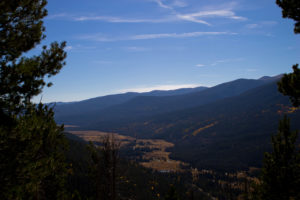 TU staff along with Grand County and a number of environmental organizations discouraged the leasing of these parcels that were close to both the Colorado River and Rocky Mountain National Park. These areas also contained cutthroat trout habitat. TU and partners commented on the potential impact to the wildlife resources and recreation in the area to the BLM throughout the NEPA process. The other organizations who commented on these potential leases played a large role in the removal of these parcels, but the sportsmen’s perspective that TU provides seemed to be especially influential in many of these efforts.
TU staff along with Grand County and a number of environmental organizations discouraged the leasing of these parcels that were close to both the Colorado River and Rocky Mountain National Park. These areas also contained cutthroat trout habitat. TU and partners commented on the potential impact to the wildlife resources and recreation in the area to the BLM throughout the NEPA process. The other organizations who commented on these potential leases played a large role in the removal of these parcels, but the sportsmen’s perspective that TU provides seemed to be especially influential in many of these efforts.
“TU’s members should feel great about the impact their contribution has to the places that sportsmen are passionate about,” said Baskfield. “It takes several staff members to participate in just one of these efforts. The staff who work on these comments and follow these processes are incredibly passionate, intelligent, and thorough when it comes to producing the desired outcome for the resource. It isn’t the most visible part of the work that we do, but it is rewarding to work with all of those talented staff members and get a win.”



